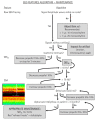Intraoperative pediatric electroencephalography monitoring: an updated review
- PMID: 38228393
- PMCID: PMC11150110
- DOI: 10.4097/kja.23843
Intraoperative pediatric electroencephalography monitoring: an updated review
Abstract
Intraoperative electroencephalography (EEG) monitoring under pediatric anesthesia has begun to attract increasing interest, driven by the availability of pediatric-specific EEG monitors and the realization that traditional dosing methods based on patient movement or changes in hemodynamic response often lead to imprecise dosing, especially in younger infants who may experience adverse events (e.g., hypotension) due to excess anesthesia. EEG directly measures the effects of anesthetics on the brain, which is the target end-organ responsible for inducing loss of consciousness. Over the past ten years, research on anesthesia and computational neuroscience has improved our understanding of intraoperative pediatric EEG monitoring and expanded the utility of EEG in clinical practice. We now have better insights into neurodevelopmental changes in the developing pediatric brain, functional connectivity, the use of non-proprietary EEG parameters to guide anesthetic dosing, epileptiform EEG changes during induction, EEG changes from spinal/regional anesthesia, EEG discontinuity, and the use of EEG to improve clinical outcomes. This review article summarizes the recent literature on EEG monitoring in perioperative pediatric anesthesia, highlighting several of the topics mentioned above.
Keywords: Anesthesia; EEG; Electroencephalogram; Electroencephalography; Pediatric anesthesia; Pediatric..
Conflict of interest statement
No potential conflict of interest relevant to this article was reported.
Figures






References
-
- Chan MT, Hedrick TL, Egan TD, García PS, Koch S, Purdon PL, et al. American Society for Enhanced Recovery and Perioperative Quality Initiative Joint Consensus Statement on the role of neuromonitoring in perioperative outcomes: electroencephalography. Anesth Analg. 2020;130:1278–91. - PubMed
-
- Nimmo AF, Absalom AR, Bagshaw O, Biswas A, Cook TM, Costello A, et al. Guidelines for the safe practice of total intravenous anaesthesia (TIVA): Joint Guidelines from the Association of Anaesthetists and the Society for Intravenous Anaesthesia. Anaesthesia. 2019;74:211–24. - PubMed
-
- Disma N, Veyckemans F, Virag K, Hansen TG, Becke K, Harlet P, et al. Morbidity and mortality after anaesthesia in early life: results of the European prospective multicentre observational study, neonate and children audit of anaesthesia practice in Europe (NECTARINE) Br J Anaesth. 2021;126:1157–72. - PubMed
Publication types
MeSH terms
Substances
Grants and funding
LinkOut - more resources
Full Text Sources
Miscellaneous

